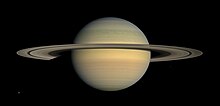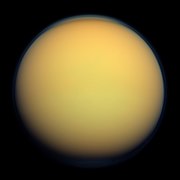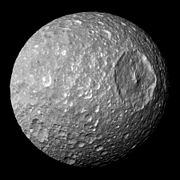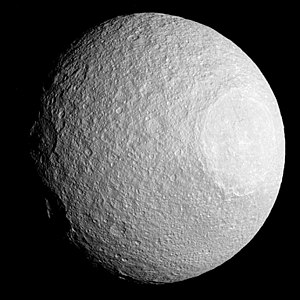Solar System/Saturn

Saturn is the sixth planet from the Sun and is the second largest planet (after Jupiter), with a diameter of 120536 kilometers (9.4 times that of Earth). Saturn is known for its spectacular rings, which can be clearly seen with a home telescope of modest size. Saturn is one of the four gas giants. Even though Saturn is much more massive than Earth, if it had a solid surface and you stood on it you would weigh only 6% more than you do on Earth. This is because you would be standing much farther from the center of the planet than you do on Earth.
Orbit
[edit | edit source]Saturn orbits the Sun in 29.46 Earth-years, with an orbital eccentricity of 0.05 and an average distance from the Sun of 9.54 AU (Earth-Sun distances).
Rotation
[edit | edit source]Saturn rotates prograde (in the direction of its path around the Sun) once every 10 hours 14 minutes, with an axial tilt of 25.33°.
Physical characteristics
[edit | edit source]Saturn is the only planet that is less dense than water—in fact its density is just 0.69 that of water.
Regions
[edit | edit source]Atmosphere
[edit | edit source]Clouds and winds
[edit | edit source]Spots
[edit | edit source]Vortices
[edit | edit source]Internal structure
[edit | edit source]
Magnetic field
[edit | edit source]Magnetosphere
[edit | edit source]Rings
[edit | edit source]

The most beautiful planetary system
[edit | edit source]The discovery Of Saturn's rings
[edit | edit source]Composition of the rings
[edit | edit source]The origin of the rings
[edit | edit source]The shepherd satellites
[edit | edit source]"Spokes" or radial formations
[edit | edit source]Satellites
[edit | edit source]Titan
[edit | edit source]Titan is the second largest moon in the solar system and has a diameter over 5% greater than that of the planet Mercury. It is the only planetary moon that has a thick atmosphere made of nitrogen. Titan has lakes made of liquid methane.
By 7.8 billion years in the future, when Sun will become a red giant star, Titan will become habitable.
-
Titan in true color.
-
Haze from the atmosphere of Titan.
-
Image from the surface of Titan, taken by the probe Huygens.
-
Diagram of Titan.
Mimas
[edit | edit source]-
Mimas
-
Crater on Mimas
Enceladus
[edit | edit source]-
Enceladus
-
Close up
-
Terrain close up
-
Plumes of Enceladus
-
Orbit of Enceladus
Tethys
[edit | edit source]-
Tethys











